Discover the famous Spanish novel Don Quijote de la Mancha in our Level 4 curriculum: A fully illustrated retelling for advanced level.
There’s so much more to learning Spanish than simply learning vocabulary and grammar. Understanding the culture, history, arts, and literature behind the language are equally important for raising bilingual children.
At Llamitas Spanish, we spend a lot of time teaching Spanish language arts and literacy through stories, going beyond learning vocabulary to teach children how to read and write in Spanish too.
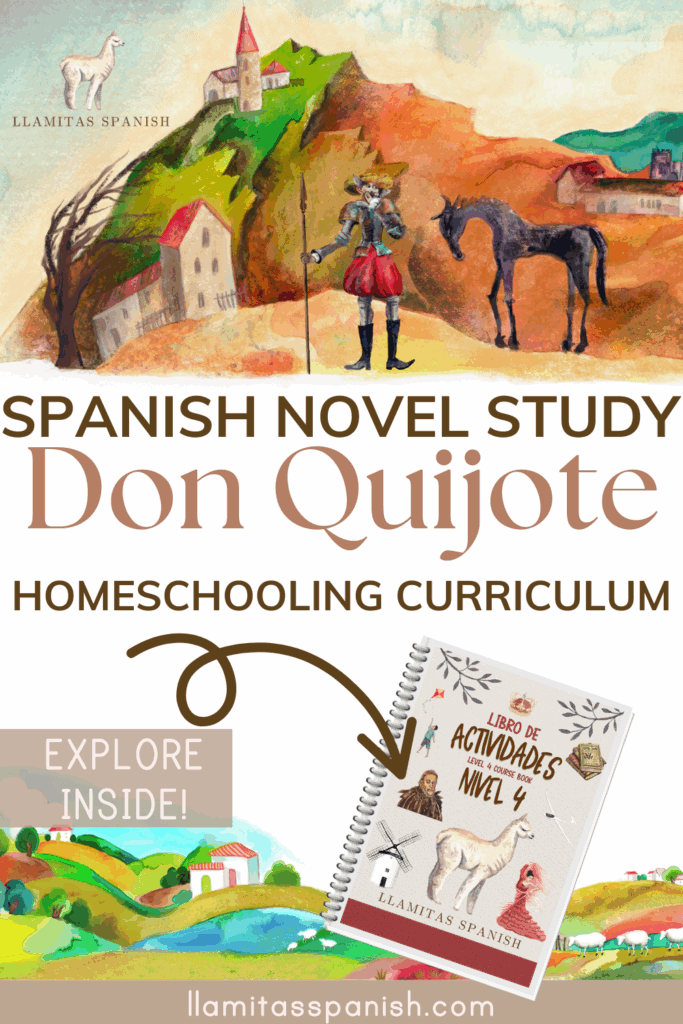
With this goal in mind, our Level 4 curriculum includes a fully illustrated, bilingual retelling of a famous story from Spain: Don Quijote de la Mancha. Heard of it? This Spanish novel is widely considered to be the first modern novel and even one the most important books of all time for its influence on literature.
In addition to teaching Spanish through stories, we also teach through cross-curricular units. Our Level 4 themes are inspired by events in Don Quijote and include:
- El mundo hispanohablante (The Spanish Speaking World): Geography and Social Studies
- Fuerzas en movimiento (Forces in Motion): Physics
- Rocas y cuevas (Rocks and Caves): Geology
- El gobierno de Estados Unidos (U.S Government): Civics
Ready for an absurd adventure filled with chivalry, fantasy, and plenty of laughs? Don Quijote won’t disappoint!
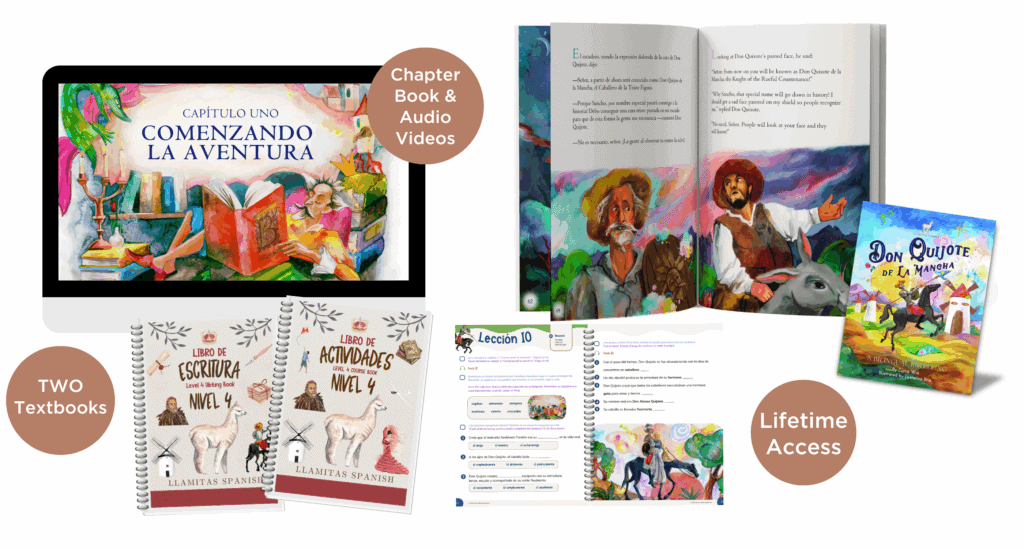
Table of Contents
Who wrote Don Quijote de la Mancha?
Don Quijote de la Mancha was written by Miguel de Cervantes Saavedra. If you’re familiar with the story of Don Quijote, it may come as no surprise that the author of this adventurous story lived a fascinating life himself.
Born in 1547 in Alcalá de Henares, Spain, Cervantes was one of seven children. He was the second child of Rodrigo de Cervantes, a surgeon and barber, and his wife Leonor de Cortinas.
Cervantes studied art and literature in Rome, later serving in the Spanish Navy alongside his brother, Rodrigo. The two were taken as prisoners by pirates, and Cervantes spent five years in captivity in Algiers before being released and returning to Madrid. It was during this imprisonment that Cervantes began to write the story of Don Quijote.
He wrote other novels, short stories, poems, and plays throughout his life, having only mild success and often facing harsh criticism. Though now considered one of the greatest Spanish language writers of all time, Cervantes was not widely recognized during his lifetime and lived most of his life in poverty before passing away at the age of 69 on April 22, 1616.
Still, Cervantes achieved his dream of literary success through his novel Don Quijote because of its lasting influence on modern literature. He pioneered the long-form narrative structure of present-day novels and explored themes about the human condition that had not previously been touched on, paving the way for many writers to come.
Related post: Libros vivos: Living Books in Spanish
What is the story of Don Quijote de la Mancha about?
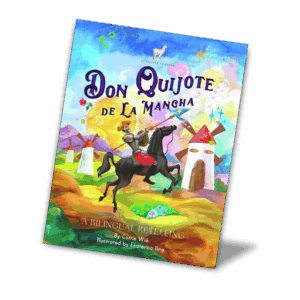
Published in two parts, in 1605 and 1615, Don Quijote tells the story of Don Alonso Quijano, a man of ideals who seeks to right the wrongs of the world. This eccentric hero, who has a hard time distinguishing reality from fantasy, believes he is a knight and sets off on his quest donning a rusty set of armor.
Accompanied by his squire Sancho Panza, an illiterate farmer who comes along just for the possibility of a reward (money), Don Quijote gets himself into all kinds of ridiculous situations on his adventure. Caught up in his delusions, Don Quijote famously attacks windmills, believing they’re giants, as well as a flock of sheep, believing they’re an army. At one point, he sets criminals free, only for them to turn on him.
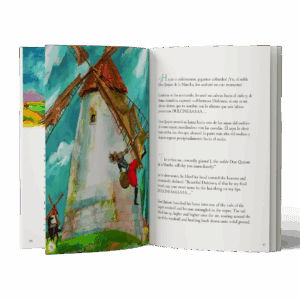
Don Quijote combines humor, adventure, and idealism to tell a story with a surprising amount of heart. For how ridiculous the character Don Quijote often is, his idealism can certainly be infectious as he seeks to make the world a better place. It’s no wonder the novel continues to be popular to this day!
Related post: How to Develop Spanish Narration Skills
Don Quijote in Our Level 4 Llamitas Spanish Curriculum
Learning Spanish through stories is an important part of our curriculum levels at Llamitas Spanish. That’s why we’ve included our abridged retelling of Don Quijote de la Mancha in our Level 4 curriculum. Here’s an overview of what students will learn:
Themes and Conflict in the Story
Students will dive into several themes and study them in our corresponding textbook. These include reality versus fantasy, love, honor, and friendship.
The major conflict throughout the story is Don Quijote’s battle with his own idealism versus reality. In addition, there’s conflict between himself and society, himself and nature, as well as with other characters. All of these are studied and developed throughout the curriculum.
Grammar in Level 4
In Level 4, we teach grammar concepts through the story of Don Quijote. This approach is extremely effective, allowing students to learn in context—avoiding rote learning with conjugation charts. Instead of repetitive drilling, students will study tenses, metaphors, similes, idioms, prepositional phrases, punctuation, spelling, and much more!
Reading comprehension and an understanding of literary elements are also developed through event sequencing, true and false activities, fill-in-the-blanks, Venn diagrams, and other advanced activities.
Developing Writing PracticE
Students will also have the opportunity to develop their writing skills in Spanish throughout Level 4. Each unit has several corresponding writing prompts with opportunities to study short texts. In addition, students will learn about a story map with the core elements of exposition, rising actions, climax, falling action, and resolution.
Throughout the course, students will even slowly build up to writing their own short story within these parameters! These activities will help students to develop high quality written work and study skills at this level.
Related post: Dual Language Homeschool Education
Homeschool Spanish Curriculum Levels
At Llamitas Spanish, we know how hard parents work—that’s why we’re here to support you in raising bilingual and biliterate children. With our robust, open & go Spanish curriculum, teaching your kids Spanish is so easy!
We now have five curriculum courses to support your child’s dual language education at home, ranging from Preschool (Morning Binder), to beginners (Level 1) and all the way to our advanced learners (Level 4).
All of our curriculum levels teach your kids Spanish using a cross-curricular, thematic approach to language learning—exploring topics kids love through stories, songs, games, cultural studies, and much more.
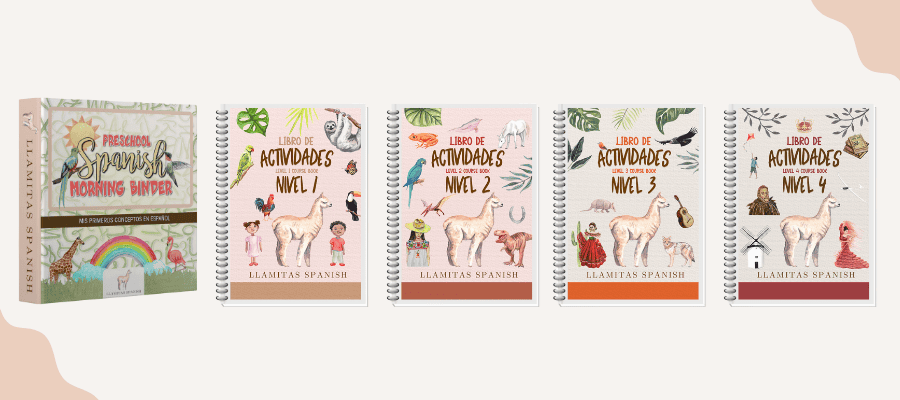
With everything you need to teach your kids Spanish at home, including bilingual teacher scripts and activities, all you have to do is open your book and go!
